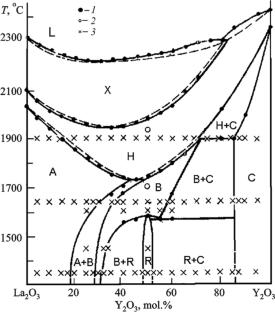Interaction of Lanthanum, Yttrium, and Gadolinium Oxides at 1600°C
Abstract
Phase equilibria and structural transformations in the La2O3–Y2O3–Gd2O3 system at 1600°C were studied by X-ray diffraction, electron microscopy, and petrography in the entire composition range. Fields of solid solutions based on hexagonal (A) modification of La2O3, cubic (C) modification of Y2O3, and monoclinic (B) modification of La2O3 (Gd2O3) were identified in the system. The starting materials were La2O3, Gd2O3, and Y2O3 (99.99%) powders. Samples were prepared with concentration steps of 1–5 mol.%. Weighed portions of the oxides were dissolved in HNO3 (1 : 1) solutions. This was followed by evaporation of the solutions and decomposition of the nitrates at 800°C for 2 h. The samples were heat-treated in three stages: 1100°C (168 h), 1500°C (70 h), and 1600°C (10 h) in air in furnaces with FeCrAl (H23U5T) and molybdenum disilicide (MoSi2) heating elements. X-ray diffraction analysis was carried out using the powder method with a DRON-3 diffractometer at room temperature (Cu-Kα radiation). The scanning step was 0.05–0.1° at angles 2θ = 15–90°. The isothermal section of the La2O3–Y2O3–Gd2O3 phase diagrams at 1600°C was characterized by three single-phase (A-La2O3, B-La2O3 (Gd2O3), C-Y2O3) and two two-phase (A + B, B + C) regions. The solubility limits were determined, and composition dependences of the lattice parameters for the phases formed in the system were plotted. No ordered perovskite-type phase was found in the system at 1600°C. A continuous series of solid solutions based on the monoclinic modification of B-La2O3(Gd2O3) formed in the system and occupied the largest area of the isothermal section. Yttrium oxide stabilized the total mutual solubility of lanthanum and gadolinium oxides. With the addition of heavier ions, the lattice parameters of the B modification reduced and the lattice volume and, accordingly, density increased. The lattice of solid solutions based on the B modification of rare-earth metal oxides became more densely packed with a higher concentration of yttrium oxide.


 求助内容:
求助内容: 应助结果提醒方式:
应助结果提醒方式:


